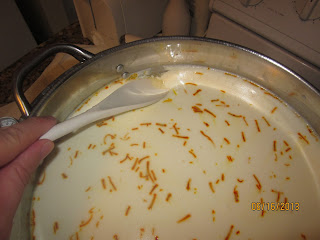NEW CHEESE PRESS!!!!
I have to admit I have been bad. I did not make any cheese in April or May. I think I was just discouraged because the cheese press I had was cumbersome and difficult to work with. But lo and behold my wife gave me new press, a dutch cheese press for Father's Day. I was very excited and it worked great. I think it looks so great that I don't mind it being out on the table, not sure if my wife agrees with me. So I made some cheese that very same day. I also taught a Mozzarella class early this month. I had donated for a work charity event a cheese class for 5 people. So I taught the class to my co-worker and her daughters. We did 2 batches during the class and they both turned out (with a little bit of coaxing) and we all had fun.
My first cheese I decided to make with my new press was my favorite, Manchego (to read about my first Manchego and some history go to this post). I changed the recipe a little bit this time but not by much. It is a combination of the recipe found in Ricki Carroll's book "Home Cheese Making", Mary Karlin's "Artisan Cheese making at Home", and a few of my own changes.
Recipe:
- 3 Gallons whole Milk
- saffron threads (some boiled in water)
- 1/4 tsp. calcium chloride in 1/4 cup cool water
- 1/8 tsp. Buttermilk Culture
- 1/8 tsp. Mesophilic Culture
- 1/4 tsp. Thermophilic Culture
- 1/4 tsp. lipase in 1/4 cup cool water
- 1/4 rennet tablet in 1/4 cup cool water
-Add Calcium Chloride and stir
-Sprinkle in all cultures, let hydrate 3 minutes then stir in a up and down motion
-Let sit covered for 45 minutes at the 86°F
-Add Lipase Powder and stir gently
-Add Rennet and gently stir with whisk
-Let sit covered for 30 Minutes (or until clean break)
-Cut curds into 1/2 inch cubes and let sit for 5 minutes
-Cut curds into rice size using whisk
-Let sit for 30 minutes
-Heat curds slowly to 104°F increasing temperature slowly and gently stirring (over 30 minutes)
-Let Curds sit for 5 minutes
-Line cheese mold with damp cheesecloth and ladle curds into mold
-Press at 15 lbs. for 15 minutes (See how nice and easy this was, because of the leverage I only needed a 5l lb. weight in order to get to 15 lbs.)
-Remove cheese and flip, returning it to mold and press again at 15 lbs. for 15 minutes
-Repeat process again and press at 15 lbs. for 15 minutes
-Flip cheese again and press for 30 lbs. for 8 hours
 |
| I love my cheese press! Thank you wife! |
-Pat cheese dry and age (I will age it for 2 months but you can age it from 3 weeks to 12 months)
 |
| my final product, I think it looks great |
 |
| This was a previous Manchego. I think my new press makes the cheese so much better |
I really enjoyed my new press and how easy it was to press the cheese without it coming out lopsided. I am already planning on making some cheese again this weekend. Not sure what I might do. Most likely a cheddar or a Parmesan. Or if I get any votes or suggestions before then I might change my mind.
































.JPG)














